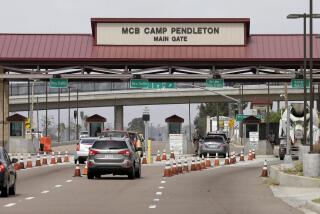Didn’t Check for Possible Navy Role in 2 Boat Deaths, Investigator Says
- Share via
A former Coast Guard officer who investigated the mysterious deaths three years ago of two fishermen near San Clemente Island testified Wednesday that he conducted his inquiry on the assumption that the Navy played no role in the deaths.
Consequently, former Lt. Robert Murray said that he did not thoroughly examine the possibility of involvement in the incident by the Navy, nor did he attempt to seek out expert opinion on whether the men’s boat, the Cindy Fay, could have been destroyed by an explosion.
Boyd Reber, skipper of the Cindy Fay, was found dead March 2, 1986; the body of his first mate, Frank Germano, was found the next day. They had been fishing in the Mail Point area of the island for soupfin shark by dragging their nets along the floor of the ocean. Because the southern part of the island is regularly used by the Navy for target practice, unexploded ordnance is believed to be in the waters off the island.
$6-Million Lawsuit
Some wreckage from the Cindy Fay was found ashore, other wreckage was submerged about 1,000 feet offshore. Reber’s widow has brought a $6.5-million lawsuit against the federal government alleging that unexploded ordnance or an errant missile was somehow responsible for the boat’s destruction.
Attorneys for Cynthia Reber say that the Coast Guard’s investigation was conducted in a manner to mask any Navy responsibility for the deaths.
Murray told U. S. District Judge J. Lawrence Irving, who is hearing the trial without a jury: “It did not appear to me (there) had been an explosion. There would have been more wreckage.”
Because Murray considered the possibility of a Navy explosive striking the Cindy Fay to be “remote,” he did not check to see if the Coast Guard had issued a warning to boats in the area alerting them to pending Navy shore bombardment on Feb. 25, 1986, believed to be the date of Reber’s death.
Murray also did not interview other fishermen in the area or a helicopter pilot who may have spotted the submerged part of the Cindy Fay wreckage.
Comment in Interview
Murray stated in an interview with The Times in April, 1987, that the deaths could not have been caused by an explosion because the wreckage of the Cindy Fay would not have drifted ashore. “A vessel that explodes isn’t going to float ashore intact,” Murray said.
But Murray testified Wednesday that, although the helicopter pilot who conducted a search for the Cindy Fay told him he spotted submerged wreckage from the boat, he dismissed the report.
“Apparently very little was submerged. I considered that aviators made a ‘best guess’ that the wreckage was underwater,” Murray said. He added that he was first told that the wreck was submerged, but that, when he went to the island and saw the wreckage on the shore, “somehow I was extremely certain the helicopter pilot never saw a submerged wreck.”
An underwater diving expedition conducted by friends of Reber turned up debris from the Cindy Fay that weighed as much as 250 pounds, but Murray testified that he never made an attempt to see that debris.
Murray, who told The Times in 1987 that a missile from Navy ships would have had to “go over a mountain to reach the Cindy Fay,” conceded Wednesday that, when he made that statement to the press, he did not know the coordinates of the destroyers Fife and Elliot.
Murray testified Wednesday that he also did not investigate a fisherman’s report of finding ordnance off San Clemente Island. “After 40 years of shore bombardments, I’m not surprised there are things in the water . . . naval ordnance,” he said.
No Link to Munitions
Murray said no underwater explosive experts were retained in the Cindy Fay investigation because he “didn’t think there was justification for it.”
“When I looked at what was found, I concluded that this very apparently was a shipwreck . . . very unlikely caused by munitions.”
Murray said the wreckage obtained from the shore of the island was discarded after it was picked up by the frigate Bronstein because the Bronstein’s captain received no further directive from the Coast Guard for its disposition, Murray said.
Outside the courtroom Wednesday, Murray, who is no longer in the Coast Guard, defended his investigation: “What would appear to be negligence in my investigation is only a reflection of the fact that we considered the possibilities (of Navy involvement) so remote that we didn’t pursue them.”
Murray said any explosion, the likelihood of which he considers remote, would have had to be from propane on board the Cindy Fay or from munitions picked up from the ocean floor.
However, attorneys for both sides agreed Wednesday to rule out a propane explosion as the cause of the Cindy Fay’s destruction.
Testimony in the case will continue today.
More to Read
Sign up for Essential California
The most important California stories and recommendations in your inbox every morning.
You may occasionally receive promotional content from the Los Angeles Times.













